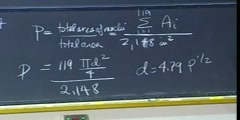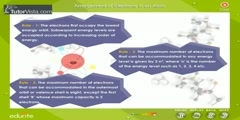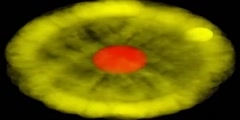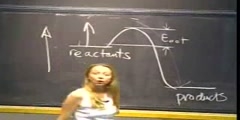Lec 9 - Chladni Figures and One-Electron Atoms
"Lec 9 - Chladni Figures and One-Electron Atoms" Freshman Organic Chemistry (CHEM 125) After showing how a double-minimum potential generates one-dimensional bonding, Professor McBride moves on to multi-dimensional wave functions. Solving Schrödinger's three-dimensional differential equation might have been daunting, but it was not, because the necessary formulas had been worked out more than a century earlier in connection with acoustics. Acoustical "Chladni" figures show how nodal patterns relate to frequencies. The analogy is pursued by studying the form of wave functions for "hydrogen-like" one-electron atoms. Removing normalizing constants from the formulas for familiar orbitals reveals the underlying simplicity of their shapes. 00:00 - Chapter 1. 1-D Bonding from Double-Minimum Potentials 09:03 - Chapter 2. Addressing Multi-Dimensional Problems: Chladni's Acoustics 22:52 - Chapter 3. Applying Chladni's Nodal Patterns to the Form of One-Electron Atoms 32:05 - Chapter 4. Removing Normalizing Constants to Understand Orbital Shapes Complete course materials are available at the Open Yale Courses website: http://open.yale.edu/courses This course was recorded in Fall 2008.
Video is embedded from external source so embedding is not available.
Video is embedded from external source so download is not available.
Channels: Chemistry (General)
Tags: Tunneling wave function Chladni figures double well potential
Uploaded by: yalefreshorganic ( Send Message ) on 05-09-2012.
Duration: 49m 36s
Here is the next lecture for this course
Lec 27 - Significant Figures
05:03 | 2483 viewsLec 28 - More on Significant Figures
05:40 | 2054 viewsLec 29 - Multiplying and Dividing with Si ...
09:31 | 2367 viewsLec 30 - Addition and Subtraction with Si ...
08:59 | 2456 viewsLec 8 - How a Long-Lived Institution Figu ...
01:16:12 | 2232 viewsLec 135 - Area and Perimeter of Composite ...
06:12 | 2422 viewsLec 64 - P Wave Function (Quiz)
04:35 | 2458 viewsLec 8 - One-Dimensional Wave Functions
49:51 | 2796 viewsChemical Science - Matter As a Wave - Lec ...
44:24 | 13862 viewsLec 5 - EE290f Multi-Electron Atom, Atom ...
01:20:12 | 2889 viewsChemical Science - Discovery of Nucleus - ...
35:15 | 21056 viewsChemical Science - Hydrogen Atom - Lecture 6
47:24 | 23549 viewsElectron's Arrangement In An Atoms
03:30 | 5542 viewsAtom wave functions
02:32 | 2298 viewsChemical Science-Atomic Theory of Matter ...
41:59 | 24363 viewsNo content is added to this lecture.
This video is a part of a lecture series from of Yale
Lecture list for this course
Lec 2 - Force Laws, Lewis Structures and Resonance
Lec 3 - Double Minima, Earnshaw's Theorem and Plum-Puddings
Lec 4 - Coping with Smallness and Scanning Probe Microscopy
Lec 6 - Seeing Bonds by Electron Difference Density
Lec 7 - Quantum Mechanical Kinetic Energy
Lec 8 - One-Dimensional Wave Functions
Lec 10 - Reality and the Orbital Approximation
Lec 11 - Orbital Correction and Plum-Pudding Molecules
Lec 12 - Overlap and Atom-Pair Bonds
Lec 13 - Overlap and Energy-Match
Lec 14 - Checking Hybridization Theory with XH_3
Lec 15 - Chemical Reactivity: SOMO, HOMO, and LUMO
Lec 16 - Recognizing Functional Groups
Lec 17 - Reaction Analogies and Carbonyl Reactivity
Lec 18 - Amide, Carboxylic Acid and Alkyl Lithium
Lec 19 - Oxygen and the Chemical Revolution (Beginning to 1789)
Lec 20 - Rise of the Atomic Theory (1790-1805)
Lec 21 - Berzelius to Liebig and Wöhler (1805-1832)
Lec 22 - Radical and Type Theories (1832-1850)
Lec 23 - Valence Theory and Constitutional Structure (1858)
Lec 24 - Determining Chemical Structure by Isomer Counting (1869)
Lec 25 - Models in 3D Space (1869-1877); Optical Isomers
Lec 26 - Van't Hoff's Tetrahedral Carbon and Chirality
Lec 27 - Communicating Molecular Structure in Diagrams and Words
Lec 28 - Stereochemical Nomenclature; Racemization and Resolution
Lec 29 - Preparing Single Enantiomers and the Mechanism of Optical Rotation
Lec 30 - Esomeprazole as an Example of Drug Testing and Usage
Lec 31 - Preparing Single Enantiomers and Conformational Energy
Lec 32 - Stereotopicity and Baeyer Strain Theory
Lec 33 - Conformational Energy and Molecular Mechanics
Lec 34 - Sharpless Oxidation Catalysts and the Conformation of Cycloalkanes
Lec 35 - Understanding Molecular Structure and Energy through Standard Bonds
Lec 36 - Bond Energies, the Boltzmann Factor and Entropy
Lec Last - Potential Energy Surfaces, Transition State Theory and Reaction Mechanism
















